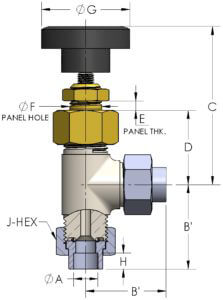Types of Angle Valves: Which One Is Right For You?
Modern valves are diverse and multi-faceted. There are hundreds if not thousands of valve types, each one has a specific job to do.
One type of valve used by an array of industry professionals is the angle valve. These valves, commonly referred to as stop valves, are most commonly used in the oil and gas industry; however, their uses are virtually endless.
Learn more about angle valves here. By knowing what they can do, you’ll know when your project requires this valve type.

Exploring the Options: Angle Valves You Can Choose From
There are several angle valve options to choose from. Some of the most common are listed here.
Compression Angle Stop
If you are dealing with CPVC or copper piping, you can use angle stop with a compression intake port. The compression angle stop (as the name implies) uses a compression nut to squeeze the attached brass ring into the area between the angle stop’s body and the building’s water pipe.
CPVC Angle Stop
For CPVC piping, which is a plastic, yellowish pipe, you can use the glue on CPVC angle stop. CPVC uses a specialized cement, which is sometimes referred to as glue.
The cement you use on CPVC also works on PVC. However, PVC cement won’t bond with CPVC. There are some all-purpose cements that work with both plastic types.
This angle stop has a small CPVC insert on the interior of the intake port.
Iron Pipe Thread Angle Stop
The pipe thread angle valve will screw onto a pipe that has male threads. An iron pipe has the threads turned on the ends; however, plastic and copper pipes require a male-adapter fitting to be installed.
Male adapters use National Pipe Thread, or NPT. All pipe types can use this angle stop option, as long as the pipe has male threads or the proper fitting.
Poly and PEX Angle Stops
Poly and PEX angle stops both attach to the respective pipe using clamp or crimp rings. These use the same installation method, but they aren’t interchangeable.
With PEX pipe, you will find it in red, white, and blue. Poly pipe is always gray.
The crimp ring is a solid band, and the ring compression tool presses the ring to the outside of the pipe. With the clamp ring tool, a tab on one side of the ring holds it in place.
Sweat Angle Stop
If copper pipes are being used, you can use the sweat angle stop valve. This angle stop is brazed onto a pipe using a torch. Because it is so affordable, most homes have the sweat angle stops installed when a house is being built.
If you aren’t competent or experienced using solder and a torch, avoid trying to use this angle stop.
Push-On Angle Stop
With a push-on angle stop, you can slide it over PEX, CPVC, and copper pipe. This valve is often called Sharkbite or Gatorbite and it doesn’t require any special tools for installation.
The valve includes stainless steel locking teeth, and a rubber O-ring. It’s the O-ring that keeps the intake port watertight. The teeth keep the valve from sliding off of the pipe.
What Angle Valve is Right for Your Project?
There are several options for angle valves. Be sure to review the options to find the one best suited for the needs of your project.
For more information about angle valves or other valves and fittings, be sure to contact us. We are the experts in this field.

